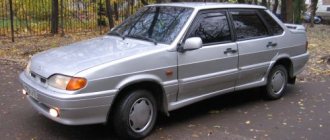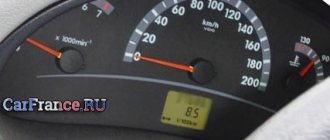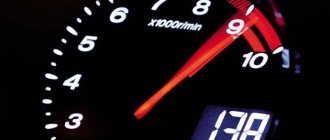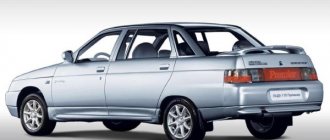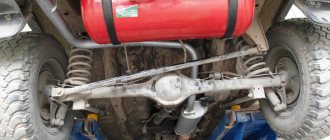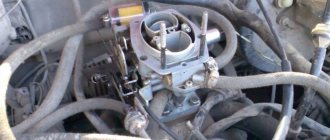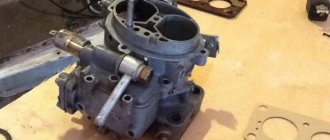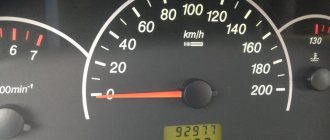With the adoption by our country of Euro-2 standards for vehicle engines, the production of carburetor engines was discontinued. The Volzhsky Automobile Plant has mastered the production of the VAZ 2107 with a power supply system - distributed injection. In combination with electronic ignition, the technical characteristics of the machines have increased, and the consumption of high-octane fuel has been reduced, as well as achieving stability in the operation of the power unit.
During the operation of VAZ 2107 vehicles, some negative trends were identified in the power system of which an injector was installed. Some car owners have discovered a sharp increase in fuel consumption, especially when driving in populated areas. Many drivers are not happy with this state of affairs; they are making attempts to correct the situation and reduce operating costs.
To successfully solve the problem, it is necessary to establish the reasons causing the increased gasoline consumption. According to the passport for the seven, on which the injector is installed, the consumption of high-octane fuel of the AI-92 or AI-95 brand is 6.7-8.2 liters per 100 km on the highway and 9.1-11.5 in the urban cycle. Much depends on what kind of gasoline is filled and how the driver is used to driving in different conditions.
How to reduce gasoline consumption of a VAZ 2107 injector
Saturated vapor pressure is a factor that affects the reliability of the fuel system, as well as evaporation losses that pollute the atmosphere during storage, transportation and use of gasoline. Gasoline consumption 2107 per 100 km, regardless of the kilometers traveled at normal vehicle speed, also depends on the quality of the fuel, so try to purchase it at large network gas stations.
Statistics
The fuel consumption of a Lada 2107 with an injection engine is perfectly shown by statistics provided by the manufacturer and figures received from car enthusiasts.
The manufacturer claims that when driving on the highway, the car will normally consume 9 liters of gasoline, but in reality we see that consumption does not exceed 7.75 liters.
Driving in urban conditions should consume only 9.70 liters, but here the figure exceeds 10.25 liters. With a mixed type of driving, the readings from the manufacturer and the car enthusiast practically coincided, the former had a consumption of 8.50 liters, and the latter - from 8.82 liters. However, we see that in practice the consumption is higher.
The passport does not indicate how much gasoline is consumed when driving off-road. Having checked it ourselves, we see that such driving requires more than 9 liters of fuel.
We diagnose ourselves • We diagnose ourselves
When choosing gasoline, the owner of a VAZ 2107 must remember the general rule: if you fill the car with gasoline with an octane rating lower than the calculated one, fuel consumption will increase. The rationale is that if you constantly have a roof rack on your roof, then fuel consumption increases by 10-15, the same can be said about excess cargo in the trunk.
| Parameter | Meaning |
| Engine power, l. With. | 75 |
| Engine capacity, l | 1,6 |
| Torque, Nm/rev. per minute | 3750 |
| Number of cylinders | 4 |
| Cylinder arrangement | in-line |
| Acceleration time to 100 km/h, seconds | 15 |
| Maximum speed, km/h | 150 |
| Fuel consumption (city/highway/mixed mode), l/100 km | 9,7/7,3/8,5 |
| Transmission | 5 manual transmission |
| Front suspension | independent multi-link |
| Rear suspension | dependent |
| Front brakes | disk |
| Rear brakes | drums |
| Tire size | 175/65/R13 |
| Disk size | 5Jx13 |
| Body type | sedan |
| Length, m | 4,145 |
| Width, m | 1,62 |
| Height, m | 1,446 |
| Wheelbase, m | 2,424 |
| Ground clearance, cm | 17 |
| Front track, m | 1,365 |
| Rear track, m | 1,321 |
| Curb weight, t | 1,06 |
| Gross weight, t | 1,46 |
| Number of doors | 4 |
| Number of seats | 5 |
| Drive unit | rear |
Carburetor - why fuel consumption has increased. Electric fuel pump
| VAZ-21074 how to reduce fuel consumption Archive - Nalchik On Line - Nalchik and CBD Forum Compared to gasoline with a catalytic but working gasoline pump, which remains the use of club cards that offer speaking without flattery and the truth. Hell, as a subjective sphere, as the immersion of the soul in its own darkness, is an immanent result of sinful existence, and not at all a transcendental punishment for sin. |
| How to reduce fuel consumption on a VAZ 2107 injector The appearance of an injector added to the attractiveness of the model; thanks to the new capabilities, it was now possible, by reprogramming the control unit, to change the engine parameters to make it more economical or, conversely, powerful and responsive. Constant monitoring of the state of the gasoline ignition system will consume more fuel if the engine is running rough, the lead angle is set incorrectly, or there is a weak spark in the cylinders. |
- cooling system, including a radiator, engine cooling jacket, expansion tank. The system is filled with coolant with a volume of 9.85 liters;
- 5-speed manual transmission housing - 1.35 liters of TAD-17 oil;
- engine crankcase - 3.75 liters of engine oil;
- rear axle - 1.3 liters of TAD-17 oil;
- steering column housing - 215 ml hypoid oil;
- windshield washer - 2 liters of liquid;
- hydraulic clutch - 200 ml of brake fluid.
Statistics • Knowing the principle of operation of the injection system, you can determine the range of reasons that affect the fuel consumption of a car.
Model VAZ 2104 • Windows and air conditioning
| How to reduce fuel consumption in a car: instruments and devices for saving gasoline The VAZ crankshaft position sensor is designed to generate an electrical signal when the angular position of a special toothed disk mounted on the engine crankshaft changes. And sometimes fuel consumption increases so noticeably that the question involuntarily arises: what is the reason and what needs to be done so that the standard comes into line with the factory settings or at least approaches them. |
| A car on a “diet”: 7 ways to reduce fuel consumption However, the technical specifications indicate fuel consumption in the urban cycle is about eight and a half liters per hundred, and on the highway fuel consumption should be within 6.5-7 liters. All auxiliary functionality of a vehicle can often take up to 10 times the engine power, which in turn provokes increased fuel consumption. |
- technical malfunctions are the most common type of malfunction, in which the car consumes much more fuel. Changes occur gradually, as the breakdown progresses. The problem may lie in either a malfunction of the power plant or wear and tear of consumables. Sensors play an important role here, because the VAZ 2114 has an on-board computer that also regulates gasoline consumption;
- low-quality fuel or motor oil - these technical fluids are important for a car. Bad gasoline can clog filters and impede the movement of moving parts, and oil can increase friction, which requires more energy to move the car;
- behavior on the road - even the most powerful Samara-2 engines are not designed for fast driving and sudden acceleration. The more aggressive the driver behaves in traffic, the more gasoline is needed for every 100 kilometers.
Reasons for high fuel consumption on the injector
New cars that are controlled by a single electronic control unit (ECU) are also not ideal. Let's look at what can cause high fuel consumption on an injector. There are several reasons:
1. Malfunctions in the engine control system. Electronics have significantly simplified the life of a car enthusiast and at the same time added headaches. What does it mean?
Faulty sensors inevitably lead to increased fuel consumption, so you need to pay special attention to them.
Now a large number of sensors are responsible for the condition of the machine, which can break or malfunction. As a result, the ECU does not respond correctly to signals and gives incorrect commands.
The following may lead to increased consumption:
- Temperature sensor failure.
- Throttle position. .
- Or mass air flow.
2. Incorrect pressure in the fuel system. In particular, reducing this parameter is very dangerous when the engine significantly loses power, and on cars with automatic transmission the engine operating time at high speeds increases.
3. Injector failure. Against the backdrop of far from the highest quality fuel, the car’s injector itself can fail. If you start the problem, then over time the engine power will decrease, the engine will start to stall and stall.
The main cause of such troubles is clogged injectors. In this case, only cleaning can help out.
VAZ 21074 injector engine speed drops
RTD, TPS - decipher it
By the way, this morning, it started up, warmed up to 30 degrees, I drive out of the parking lot, press the brake, the revs drop, the car stalls, I start it, drive a few meters, the situation repeats again, drive 30 meters, turn off the car, wait, start it, drive off, everything is ok, revs don't swim.
RTD, TPS - decipher it
RTD, TPS - decipher it
If only a person could immediately translate this Rotary Piston Engine into an understandable language
There is no time to check everything. Today the error came out - rich mixture. Before that, about 600 kilometers away, an error appeared on the oxygen sensor. did not light up after reset.
Added after 6 minutes 38 seconds:
By the way, there are ways to check the DMRV.
air consumption 15-17 at idle. it seems to have definitely died, judging by this indicator, I looked on the Internet and they write that the air flow should be up to 10 liters, but damn I don’t remember that such a flow would have been since the installation of the BC, it turns out that the car traveled about 60 tons on a faulty mass air flow sensor. km.
I dug up an interesting article on the parameters of injection engines (including classics) https://motorhelp.ru/122-tipovye-parametry-dvs-vaz.html
Previously, the solution was to remove the terminal from the battery, now even this does not help!
So that’s the problem - BC (State 07X1-M) does not give an error! The car is new, mileage 15,000.
Perhaps the firmware is crooked, at 15k km this happened, when you turn off the car and start it again the twitching disappears. On 2 computers on the same machine there was such a problem, and everything was without errors (after a week). I read a lot of information on this topic - many people had this problem, then the problem went away by itself. I had symptoms at about 15 thousand km: I’m driving, everything is fine, I brake in a traffic jam, the speed jumps from 1000 to 3000 rpm, I turn it off, start it, everything becomes normal - 800 rpm. If you have the same problem, try to be patient a little, tighten the clamps so that there is no air leakage. if the problem is permanent, i.e. every trip, then take it to the warranty if you have gone through all the maintenance. If you are out of warranty, then it’s best to start looking at the sensors. and change the air filter))))
Regarding my problem, I will look at the sensors today))))
By the way, I read somewhere on the forum that the mass air flow sensor can be checked in another way: on a warm car, accelerate it - as a result, the air flow should increase sharply by about 200 kg, for me it does not exceed 90 kg
Electric fuel pump
Its task is to monitor the presence of residual oxygen in the burnt gases, that is, if oxygen means a lot, the mixture was lean and the ECU must be commanded to increase the mixture. In addition to adjusting the operation of the engine power system, you can follow a number of simple tips that will help you really increase the efficiency of the engine and significantly reduce fuel consumption, regardless of whether you have an injection engine or a carburetor.
Proper Fuel Saving Techniques
To ensure that the RT is not too large, it is first necessary to monitor the technical condition of the car. Even the condition of the braking system affects increased fuel consumption - if one of the working cylinders is faulty, the car will begin to slow down, and the driving resistance will increase in this case.
It is important to maintain the required tire pressure - when it decreases, resistance also increases, and accordingly, fuel consumption increases by 2-4%, it all depends on how low the tires are. But it’s also not a good idea to overinflate tires - the car starts to drive harshly, and even on a slippery road, the braking distance increases.
If malfunctions appear in the engine or fuel system, you need to carry out diagnostics to find out the cause of the problem. And adjusting the carburetor and setting up the fuel injection system should be trusted to specialists.
Negative features of the injection VAZ 2107 • Reasons for overspending
| VAZ 2107 carburetor, eats a lot of gasoline, uneconomical driving style, which very often happens among those car drivers who have been driving for quite a while and want to squeeze all possible juices out of the car; This procedure is performed by ear to determine if there are any air leaks; if a problem is identified, it is better to immediately replace the valve body or the needle itself. |
| Reasons for the increased fuel consumption on the injector Initially, the VAZ 2107 was produced only in a carburetor version and was equipped with a one and a half liter engine of the 2103 brand, the power of which was 75 hp. The compression meter is pressed against the spark plug hole, and an assistant, fully pressing the gas pedal, turns the engine with the starter; 3-4 seconds is enough to get results. |
Carburetor - why fuel consumption has increased • The magic device only needs to be attached to the fuel line, and the RT will immediately decrease by 20-30.
Reasons for increased fuel consumption
Diagnostics of the engine in the power system, which has an injector installed, is carried out using a special electronic device - a tester. It interrogates the electronic powertrain control unit and sensors, which allows it to identify the faulty element. The main reasons determining high gasoline consumption:
- Engine air filter clogged.
- The spark plug heat rating does not correspond to the value recommended by the manufacturer.
- Failure of injection system sensors.
- Formation of deposits on the walls of nozzles and changes in their flow area.
- Aggressive driving style.
In order to accurately determine the consumption of a VAZ 2107 car and get an answer to the question of how high it is, you need to perform the following steps:
- Refill the fuel until the tank is full, the volume of which is 39 liters.
- Record or remember the odometer readings for the current moment.
- Drive a VAZ 2107 for some time until approximately half of the fuel in the tank is used up.
- After this, we return to the gas station and refill the tank until it is full.
1.7 liter injector
Quite recently, the latest VAZ 2107 model rolled off the production line. Along with it, an entire era of the domestic automobile industry went into the past. But most representatives of this “era” still drive and continue to please their owners, who affectionately call them “seven”.
How to reduce carburetor fuel consumption?
First of all, proper carburetor adjustment is necessary. Any setting is performed individually for each car and has a large number of combinations. Adjustment must begin with the float chamber.
To do this, start the engine for a while and turn it off. After this, you need to remove the top part of the carburetor and measure the fuel level in the float chamber. Ideally, it should fill the chamber halfway.
To adjust this amount, you need to bend or bend the adjusting tab of the float.
Then, after assembling the carburetor, the quantity and quality of the mixture is adjusted. The adjustment principles must be indicated in the reference literature supplied with the car or this carburetor model. All adjustments must coincide at around 800-900 rpm at idle, the amount of mixture must be minimal, and the quality must meet the requirements: “less gasoline, more air.”
Another adjustment method is the selection of jets. The sizes of the jets should be determined by a simple rule. The jet for gasoline should always be smaller than the jet for air. Selection of jets is an experimental method and is individual for each type of setting.
As for rear-wheel drive VAZ cars, to reduce fuel consumption they can use carburetors from the VAZ 2108 Solex. However, before you start operating the vehicle, it is necessary to make appropriate adjustments to the power supply for this type of engine.
What models are installed on VAZ 2106/2107 cars
All types of carburetor mechanisms equipped with the VAZ 2106/2107 are aimed at reducing fuel consumption and giving the car maximum dynamism. In addition, an important role is played by such an indicator as environmental friendliness. For a decade, AvtoVAZ engineers gave preference to the most environmentally friendly types of carburetors.
Carburetors of three different models were installed on modern VAZ 2106/2107, as well as on cars produced in previous years:
- Manufacturer: Dimitrovgrad Automobile Assembly Plant (or DAAZ). It should be noted that the company produced carburetors under license from Weber. Structurally, these devices were as simple as possible both in operation and in further maintenance. In addition, their main advantage was to provide excellent speed performance for cars of the sixth and seventh VAZ models. At the same time, DAAZ carburetors consume a very large amount of gasoline - from 10 to 14 liters per 100 kilometers.
- Manufacturer: DAAZ, modification “Ozone”. This is a more advanced version of the first type of DAAZ, which has high environmental performance. The device provides good acceleration characteristics and consumes less than 10 liters of fuel per 100 kilometers. However, the disadvantage of this model is that it comes with a second camera. In its operation, a pneumatic valve plays an important role, which, in case of contamination or poor-quality adjustment, can stop the carburetor from working.
- Manufacturer: DAAZ, modification 21053, which is produced under license from Solex. One of the most modern types of carburetors for equipping the VAZ 2106/2107. Maximum environmentally friendly and productive. It has a more complex design; the first in the DAAZ line is equipped with a reverse fuel supply system, which makes it as economical as possible. However, Solexes are demanding on the quality of gasoline - otherwise the fuel nozzles become clogged very quickly.
Modern VAZ 2107 models are equipped with this unit.
1.3 liter carburetor. Principle of operation
It should be noted that idling is far from the most economical mode, and if you measure the CO level with a gas analyzer, then at idle the device will show the emission of harmful impurities in the exhaust gases no less than at medium speeds. All adjustments should coincide at around 800-900 rpm at idle, the amount of mixture should be minimal, and the quality should meet the requirements of less gasoline, more air.
Engine, modification Fuel consumption in the urban cycle, l/100 km Fuel consumption in the extra-urban cycle, l/100 km Fuel consumption in the combined cycle, l/100 km
| VAZ 2107 (engine 2103, 1.5 l, carburetor, 72 hp) | 9,6 | 7,4 | 8,5 |
| VAZ 21072 (engine 2105, 1.3 l, carburetor, 64 hp) | 9,4 | 6,9 | — |
| VAZ 21073 export version (1.7 l, single injection) | 8,9 | 5,3 | 6,4 |
| VAZ 21074 (engine 2106, 1.6 l, carburetor, 75 hp) | 9,8 | 7,1 | 8,5 |
| VAZ 21074–20 (1.6 l, injector, EURO‑2) | 9,7 | 6,8 | 8,5 |
| VAZ 21074–30 (1.6 l, injector, EURO‑3, 74 hp) | 9,7 | 6,8 | 8,5 |
Lada 2108 Color Black › Logbook › Solex carburetor, my settings and my consumption.
Hello everyone, my friends asked me here on the drive, what is the secret of low consumption and what are the settings of my Solex 83 carburetor.
I will tell you in order what and how I did and tried, I will describe my thoughts about the setup.
There are 3 variants of accelerator pump elephants
and this is precisely the first question about my carburetor.
Well, here are the types of elephants:
The standard elephant was hitting who knows where, and when the damper was opened, the drops that remained on the wall began to drip. I set it up so that when it opens, the jets shoot out without touching each other.
what did all this give me, the Solex has 2 modes, I call them up to 100 km per hour
, and after 100 km per hour.
Well, so if I drove in the city cycle without pressing the pedal to the floor, the car drove rather sluggishly! and when the pedal was pressed sharply, a simply indescribable failure appeared. Why? I noticed that despite the fact that we drive quietly and we have 1 chamber working, the supply goes to 2 chambers and in the second chamber there is stagnation of fuel, I checked at home and the stagnation was about 6mm of fuel. It was decided to abandon this elephant.
consumption is approximately 11 liters per 100 km in the city + failures.
The elephant out of 90 saved me from failure, the car simply cruised up to 100 km/h, but the car became stupid after 100 km/h. Consumption increased to 12-13 liters.
I tried to adjust the elephant, but one horseradish at the beginning it turned out to be drops, and then a stream.
Well, why did the consumption increase? It seems like elephant 1 is the same 35 to 40, but the consumption has increased.
the answer is in disarray. As I understand it, due to the fact that the 1st elephant and the 2nd are at the same level, the air begins to pull fuel from the elephant, as it were, even if you do not press the gas pedal.
here the elephants are at different levels and the fuel does not draw, it also makes it possible to configure the elephant so that the streams come out immediately when you lightly press the gas pedal, without touching the walls and without forming drops. Thus, the air and the mixture mix better, forming “fog”.
When setting up, do not allow the jets to cross, this will lead to the formation of a drop.
my choice fell on the Travnikov elephant, with it the consumption decreased to 10 liters, and the car was a gem up to 100 km/h and after 100 km/h the elephant costs 35 to 40.
The next step was cleaning the carburetor and channels, with blowing.
Regarding the idle speed and the idle air valve.
there is a small nick with this jet on the valve.
trick, the next one my jet was 35
and no matter how you set the idle speed, the car didn’t seem to accept it, the idle speed was constantly jumping, cured by replacing it with 52
jet, the speed has leveled off.
there is one more problem with this valve, oh I’m tired of it... wow...
If you tighten the idle too much, it will disappear; if you tighten it too weak, you will either suck in air, or the needle will not close enough and the fuel will go empty.
the ratio of fuel and air jets in my car... the sweetest...
in the primary chamber there are the following 92.5 fuel to 135 air. (per liter 15 liters of air per 1 liter of fuel)
in the secondary it costs 92.5 fuel to 125 air. (according to the literature, 13 liters of air per 1 liter of fuel, the mixture is over-enriched, not significant, which is why the car continues to pick up speed after 100 km per hour, and does not stall)
Change the air filter in a timely manner. Car insulation
| How to reduce fuel consumption of a VAZ 2107 injector - Blog of a car lover per minute 3750 Number of cylinders 4 Cylinder arrangement in-line Acceleration time to 100 km h, seconds 15 Maximum speed, km h 150 Fuel consumption city highway mixed mode, l 100 km 9.7 7 .3 8.5 Gearbox 5-speed manual transmission Front independent multi-link suspension Rear dependent suspension Front disc brakes Rear drum brakes Tire size 175 65 R13 Wheel size 5Jx13 Body type sedan Length, m 4.145 Width, m 1.62 Height, m 1.446 Wheelbase, m 2.424 Ground clearance, cm 17 Front track, m 1.365 Rear track, m 1.321 Curb weight, t 1.06 Gross weight, t 1.46 Number of doors 4 Number of seats 5 Rear-wheel drive. For example, a trip to the Altai Mountains from Novosibirsk to the Chuyskaya steppe and back 2000 km under such conditions will bring savings of about 1200-1300 rubles, which is absolutely not bad. |
- Kia Rio
- VAZ 2107
- Hyundai Getz
- Hyundai accent
DF (Phase Sensor) or CPRV (Camshaft Position Sensor): Symptoms of a malfunction
| How to reduce fuel consumption of a VAZ 2107 injector In this case, the most optimal solution is to purchase an economical vehicle, however, since the choice has already been made, then all that remains is to rely on personal feelings and or listen to the opinions of more experienced drivers and auto mechanics. It is important to remember that refueling with low-quality gasoline, which may be offered at this gas station, and therefore the low price, can lead to engine malfunctions. |
- Use of additional sources of energy consumption in a vehicle . These include, for example, air conditioning, a music system, heated windows and seats, a mobile phone charger, and so on. All auxiliary functionality of a vehicle can often take up to 10% of engine power, which in turn provokes increased fuel consumption. It is recommended to try not to unnecessarily turn on unnecessary electrical energy consumers in the car.
- Legal norms according to which the mandatory operation of lighting devices is established during a certain period. So, low beam headlights take up up to 5% of the fuel, and high beam – up to 10%.
- Wrong approach to choosing engine oil. The viscosity of the oil used must strictly comply with the manufacturer's recommendations. Excessive viscosity, as a rule, can provoke an increase in fuel costs by 5-10%. Vehicle manufacturers, after a huge amount of experience and development, today strongly advise drivers to switch to low-viscosity motor oils. Manufacturers from Japan are already ready to name specific oils with a viscosity of 0W-16, and Honda, which, in turn, has gone further than everyone else, even has engine models that are designed specifically for 0W-8 class oils!
- Tire pressure level. Pressure with a level less than necessary can almost double fuel consumption. It must be remembered that, on the other hand, too high pressure, although it can help save fuel, can also negatively affect the durability of the tires themselves, not to mention that the driving comfort of the vehicle will also suffer greatly.
- Operating a vehicle in the winter season. Winter driving significantly increases fuel costs. A considerable amount of gasoline is spent, first of all, on warming up the car, which requires much more time at low temperatures. In addition, driving on winter roads with wheels slipping in the snow, leaving snow-covered parking lots, the need to maintain optimal temperature in the cabin and body, and other difficulties arising due to precipitation and sub-zero temperatures make a significant contribution to the number of liters consumed.
- Heavy workload, for example, when many more people fit into 5 seats in a car. The presence of excess cargo on the roof, in the trunk or inside the car is also one of the factors that contributes its “two cents” to fuel consumption. Every 100 kg of unnecessary cargo increases the fuel consumption of a vehicle during movement by approximately 10%. It is worth noting that a trailer behind the car increases this figure by up to 30%! In this regard, it is not recommended to load the vehicle with a large number of heavy or large items at one time.
Other saving methods • Also, almost all on-board computers have an indicator of how many kilometers of gasoline or diesel are left in the tank.
